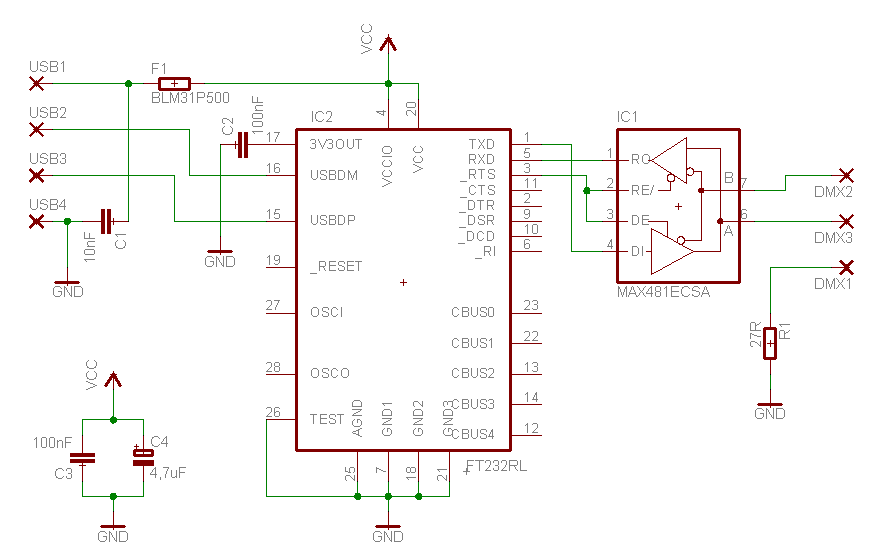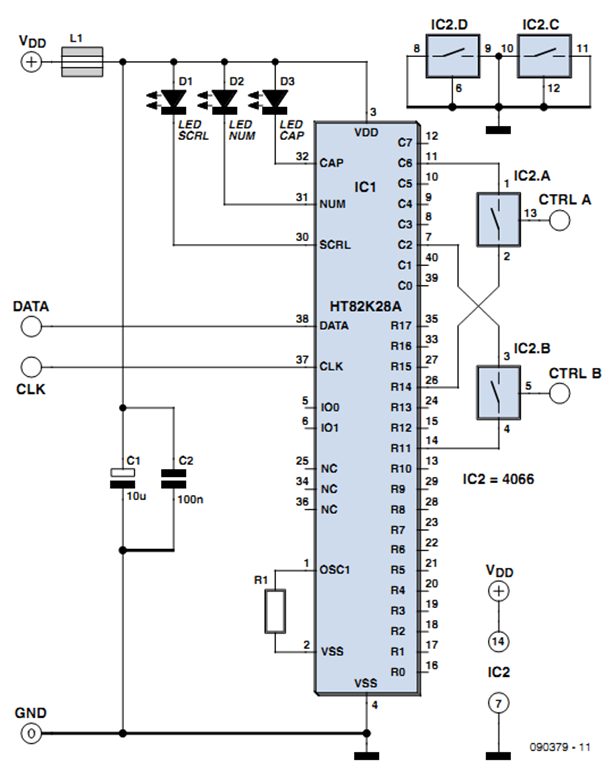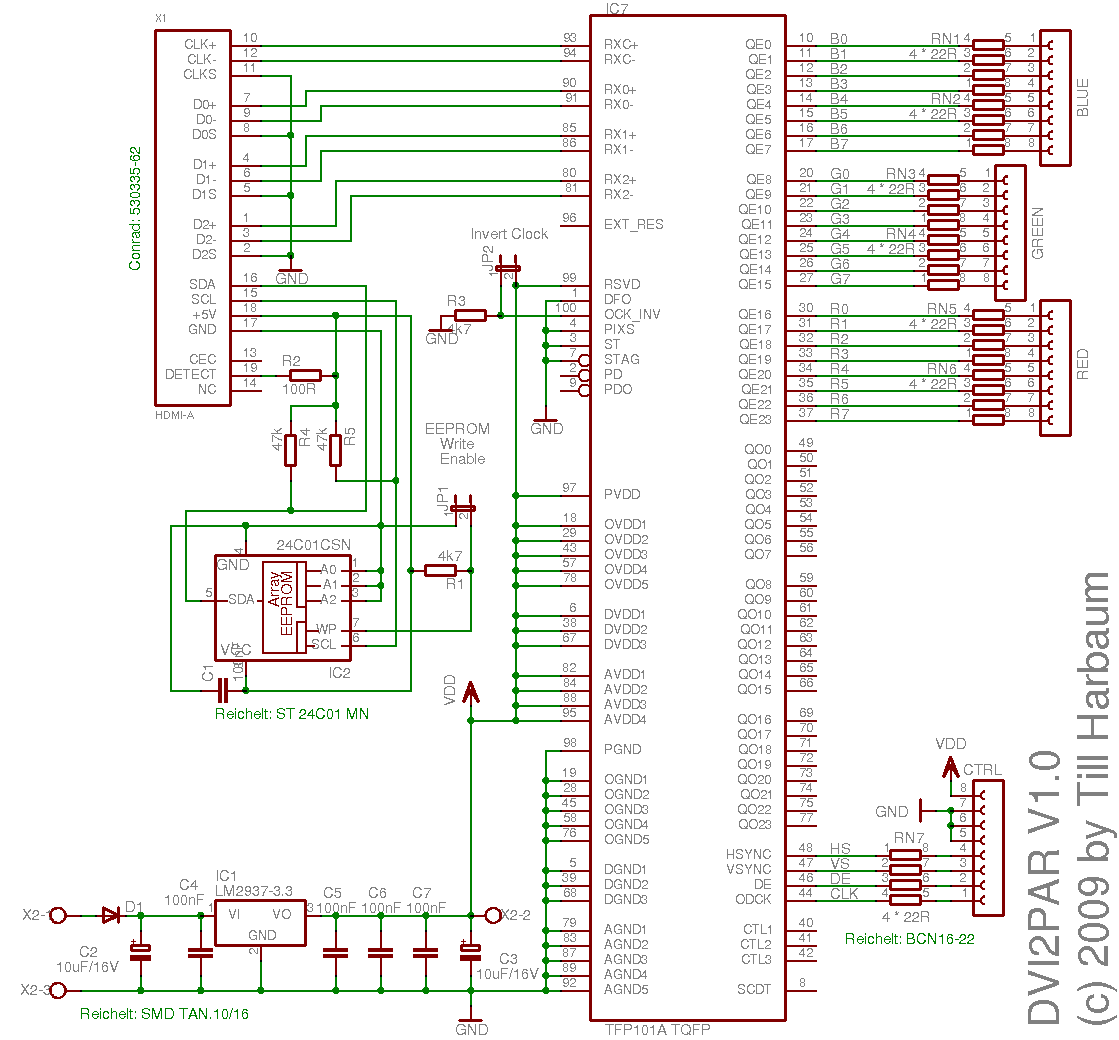
Mini USB-DMX interface

On the DMX line side, an XLR connector should be utilized, either a 3-pin or 5-pin connector. The pins in an XLR connector are typically numbered, eliminating the need for a visual reference. In the case of the 5-pin connector, only pins 1-3 are employed. The following code was used for initial circuit testing: dmx_tx_test.zip (Microsoft VC7 project). This code configures the device as a DMX transmitter and continuously sends out DMX frames until a key is pressed. By setting all channels to either 0 or 255, it was straightforward to verify that the circuit was transmitting DMX data using a standard voltmeter. The circuit is not fully compliant with USB specifications. According to the USB specification, a USB bus-powered device must not draw more than 500 µA in USB Suspend mode. The FT232RL (IC2) can properly enter low power mode; however, the MAX481 (IC1) does not. To place the MAX481 in low power mode, pins RE and DE must be set to RE="1" and DE="0". The FT232RL provides both PWREN and SLEEP signals, allowing USB Suspend mode to be managed with additional logic gates. Nevertheless, many devices that do not comply with the USB specification utilize the USB port as a power source, making the violation of USB Suspend mode less critical. There is, however, potential for improvement. Several commercial USB-DMX interfaces also utilize FTDI chips. During the circuit design, compatibility was aimed for the Enttec Open DMX USB, which uses the older FTDI chip FT232BM. Practical tests indicate that this circuit is compatible with software that supports the Enttec Open DMX USB, such as FreeStyler. Caution is advised when working with high-power equipment like dimmers, as the connection between the PC and devices that switch kilowatts of power at several hundred volts poses risks. The above circuit does not isolate the USB port from the DMX line. If everything functions correctly and no mistakes are made, there should be no concerns; however, if the DMX port on the dimmer is damaged or if a significant error occurs, there is a possibility of damaging the USB port or, in the worst-case scenario, the entire PC. Access to surface mounting equipment is available at the vocational school Yrkesskolan Optima. The development process involved careful soldering under a microscope, especially when dealing with the FT232RL chip, which is small enough to fit on a thumbnail. The reflow oven is compact but effective. Surface mounting requires a high level of craftsmanship, perhaps even more than traditional soldering. The first test with actual DMX hardware, a 6-channel dimmer, was conducted using a laptop and FreeStyler version 2.87c configured for the "Enttec open DMX" controller, and it was successful.
The DMX interface circuit is designed to facilitate communication between a DMX controller and various lighting fixtures or dimmers. The choice of an XLR connector is standard in professional lighting applications, ensuring compatibility with existing DMX equipment. The 5-pin XLR connector, while primarily utilizing only three pins for DMX data transmission, provides a robust and reliable connection.
The circuit operates by using the FT232RL chip, a USB to serial converter, which is configured to transmit DMX data frames. The code included in the project file dmx_tx_test.zip establishes the necessary communication protocol, allowing the device to send DMX frames continuously. This is particularly useful for testing and verifying the functionality of DMX fixtures. The ability to set channel values to extremes (0 or 255) simplifies the verification process, as it provides clear voltage levels that can be easily measured with a voltmeter.
The design considerations regarding USB compliance are important, especially in environments where multiple devices may be connected. The FT232RL's capability to enter low power mode is a beneficial feature, yet the MAX481's failure to do so poses a challenge that may require additional circuitry to manage power consumption effectively. The inclusion of logic gates to control the PWREN and SLEEP signals can enhance power management, ensuring that the device adheres to USB specifications.
The potential risks associated with connecting high-power equipment to a PC through a USB interface cannot be overstated. The lack of isolation between the USB port and the DMX line means that any fault in the DMX equipment could lead to damaging the computer's USB port or the entire system. Therefore, proper precautions and understanding of the equipment being used are essential.
The use of surface mount technology in the construction of the circuit demonstrates a modern approach to electronics design, allowing for compact layouts and efficient use of space. The FT232RL chip, being a small SSOP package, requires precision soldering techniques, which can be facilitated by using a microscope. This level of detail in the assembly process is critical for ensuring reliable operation of the circuit.
Overall, this DMX interface circuit represents a practical solution for integrating DMX control into a variety of lighting applications, while also highlighting the importance of careful design and testing in electronic circuit development.On the DMX line side a XLR connector should be used. Either a 5 or 3 pin connector. The pins/holes in a XLR connector are usually numbered so no need for a picture. For the 5 pin connector, only pins 1-3 are used. I used the following code to do some initial tests on the cirquit: dmx_tx_test. zip (Microsoft VC7 project). The code configures the device as a DMX transmitter and repetedly sends out DMX frames until a key is pressed. By setting all channels to either 0 or 255 it was easy to verify that the cirquit was transmitting DMX data using an ordinary voltmeter. The cirquit is not fully USB compliant. The USB spec says that a USB bus powered device must not draw more than 500 uA in USB Suspend mode. FT232RL (IC2) will correctly go into low power mode but MAX481 (IC1) will not. To set MAX481 in low power mode, pins RE and DE on MAX481 must be set to RE="1", DE="0". FT232RL provides both PWREN and SLEEP signals so USB Suspend mode could be handled with some additional gates.
However, all sorts of crazy equipment (which definitely don`t comply with the USB spec) these days use the USB port as power source, so I don`t consider the USB Suspend mode violation too serious. But, here is room for improvements. There are some ready made (commercial) USB-DMX interfaces also using FTDI chips. While designing the cirquit I tried to make it comaptible with the Enttec Open DMX USB, which uses the older FTDI chip FT232BM.
Practical tests shows that my cirquit is compatible with software supporting Enttec Open DMX USB, for example FreeStyler. When working with high power equipment like dimmers, be sure you know what you are doing! You are connecting your PC through the USB port to eqipment that switches kilowatts of power at several hundred volts.
The above cirquit does not isolate the USB port from the DMX line. If everything works correctly and you don`t make any mistakes there is nothing to worry about, but if the DMX port on your dimmer is somehow damaged, or you make a serious mistake somewhere, you might destroy the USB port or in worst case the whole PC. I have a part-time job at the vocational school Yrkesskolan Optima where I have access to surface mounting equipment.
Here are some pictures from the development process. Working (applying solder paste) under microscope is a must, at least with my eyes, when dealing with the FT232RL chip. The 28-pin SSOP chip is so small it fits well on my thumb nail. The reflow oven is, well, small, but it does the job. Surface mounting is a lot of craftsmanship, maybe even more than normal soldering. I find it facinating working under microscope. Below is a picture of the first test with some actual DMX hardware, a 6 channel dimmer. Using my laptop and FreeStyler version 2. 87c configured for the "Enttec open DMX" controller. It works! 🔗 External reference
The DMX interface circuit is designed to facilitate communication between a DMX controller and various lighting fixtures or dimmers. The choice of an XLR connector is standard in professional lighting applications, ensuring compatibility with existing DMX equipment. The 5-pin XLR connector, while primarily utilizing only three pins for DMX data transmission, provides a robust and reliable connection.
The circuit operates by using the FT232RL chip, a USB to serial converter, which is configured to transmit DMX data frames. The code included in the project file dmx_tx_test.zip establishes the necessary communication protocol, allowing the device to send DMX frames continuously. This is particularly useful for testing and verifying the functionality of DMX fixtures. The ability to set channel values to extremes (0 or 255) simplifies the verification process, as it provides clear voltage levels that can be easily measured with a voltmeter.
The design considerations regarding USB compliance are important, especially in environments where multiple devices may be connected. The FT232RL's capability to enter low power mode is a beneficial feature, yet the MAX481's failure to do so poses a challenge that may require additional circuitry to manage power consumption effectively. The inclusion of logic gates to control the PWREN and SLEEP signals can enhance power management, ensuring that the device adheres to USB specifications.
The potential risks associated with connecting high-power equipment to a PC through a USB interface cannot be overstated. The lack of isolation between the USB port and the DMX line means that any fault in the DMX equipment could lead to damaging the computer's USB port or the entire system. Therefore, proper precautions and understanding of the equipment being used are essential.
The use of surface mount technology in the construction of the circuit demonstrates a modern approach to electronics design, allowing for compact layouts and efficient use of space. The FT232RL chip, being a small SSOP package, requires precision soldering techniques, which can be facilitated by using a microscope. This level of detail in the assembly process is critical for ensuring reliable operation of the circuit.
Overall, this DMX interface circuit represents a practical solution for integrating DMX control into a variety of lighting applications, while also highlighting the importance of careful design and testing in electronic circuit development.On the DMX line side a XLR connector should be used. Either a 5 or 3 pin connector. The pins/holes in a XLR connector are usually numbered so no need for a picture. For the 5 pin connector, only pins 1-3 are used. I used the following code to do some initial tests on the cirquit: dmx_tx_test. zip (Microsoft VC7 project). The code configures the device as a DMX transmitter and repetedly sends out DMX frames until a key is pressed. By setting all channels to either 0 or 255 it was easy to verify that the cirquit was transmitting DMX data using an ordinary voltmeter. The cirquit is not fully USB compliant. The USB spec says that a USB bus powered device must not draw more than 500 uA in USB Suspend mode. FT232RL (IC2) will correctly go into low power mode but MAX481 (IC1) will not. To set MAX481 in low power mode, pins RE and DE on MAX481 must be set to RE="1", DE="0". FT232RL provides both PWREN and SLEEP signals so USB Suspend mode could be handled with some additional gates.
However, all sorts of crazy equipment (which definitely don`t comply with the USB spec) these days use the USB port as power source, so I don`t consider the USB Suspend mode violation too serious. But, here is room for improvements. There are some ready made (commercial) USB-DMX interfaces also using FTDI chips. While designing the cirquit I tried to make it comaptible with the Enttec Open DMX USB, which uses the older FTDI chip FT232BM.
Practical tests shows that my cirquit is compatible with software supporting Enttec Open DMX USB, for example FreeStyler. When working with high power equipment like dimmers, be sure you know what you are doing! You are connecting your PC through the USB port to eqipment that switches kilowatts of power at several hundred volts.
The above cirquit does not isolate the USB port from the DMX line. If everything works correctly and you don`t make any mistakes there is nothing to worry about, but if the DMX port on your dimmer is somehow damaged, or you make a serious mistake somewhere, you might destroy the USB port or in worst case the whole PC. I have a part-time job at the vocational school Yrkesskolan Optima where I have access to surface mounting equipment.
Here are some pictures from the development process. Working (applying solder paste) under microscope is a must, at least with my eyes, when dealing with the FT232RL chip. The 28-pin SSOP chip is so small it fits well on my thumb nail. The reflow oven is, well, small, but it does the job. Surface mounting is a lot of craftsmanship, maybe even more than normal soldering. I find it facinating working under microscope. Below is a picture of the first test with some actual DMX hardware, a 6 channel dimmer. Using my laptop and FreeStyler version 2. 87c configured for the "Enttec open DMX" controller. It works! 🔗 External reference





